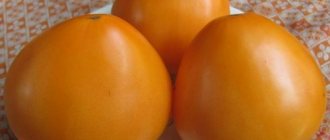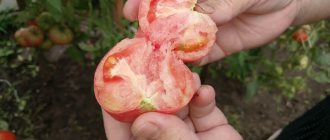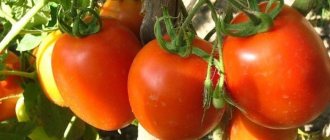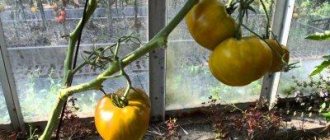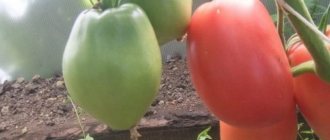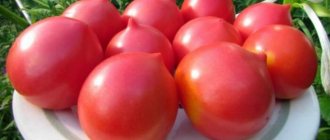Description and characteristics of tomato
“Cream” is known throughout the world for its unusual oblong shape, reminiscent of the fruit of the same name.
Other characteristics of these tomatoes include:
- dense peel, thanks to which they can be preserved whole;
- sweet taste leaving a pleasant aftertaste;
- versatility of use - salads, sauces, soups, preservation, etc.;
- a small amount of liquid in the composition, which is why the cream is not used for making juices;
- low calorie content, because 100 g of fruit contains only 22 kcal;
- excellent adaptability to transportation;
- high productivity both in open ground and in greenhouses;
- fruit weight is 50–90 g, although some varieties are capable of producing specimens up to 250–300 g;
- variety of tomato colors;
- average branching of bushes;
- dark green leaf color;
- the presence of complex inflorescences of a light yellow hue;
- The average height of the bush is up to 40–70 cm, although some subspecies are over 1.5–2 m.
Did you know? There is still debate in the world about the biological classification of tomatoes. Botanists say it is a berry. In the United States, a court ruled that a tomato is a vegetable because it can be eaten raw and is not a dessert. But the European Union defines a tomato as a fruit.
Using tomatoes
The “Giant Cream” subspecies is ideal for creating culinary masterpieces. Of course, a large mass of fruits has its drawbacks, since such tomatoes cannot be put whole in a jar, but you can make juices, ketchups, and pastes. Orange varieties of the subspecies are a storehouse of benefits for children and people on a diet. Housewives also make very tasty assorted vegetables, marinate large fruits in barrels, and the neutral taste does not spoil the taste of other vegetables. The fruits contain a very rich vitamin and mineral composition, they contain a lot of fiber - fiber, which helps our gastrointestinal tract.
Variety varieties
Now let's talk about the most famous varieties of cream tomatoes. This list includes the following types:
- "Sugar Cream" This is a variety bred in Russia for greenhouses and open ground, giving a yield of up to 8 kg per square meter. m. It is distinguished by an impressive bush (up to 1.5 m in height), so it is impossible to do without a garter. Its fruits have a red-raspberry tint, which is why the species has a second name - “Raspberry cream”;
- “Red cream”, or “Nasco”. A mid-early variety, which is characterized by high taste, strong immunity, long-term storage, due to which it is actively grown for sale on an industrial scale;
- "Pink cream." This variety surprises with its productivity, allowing you to harvest up to 20 kg of tomatoes from one bush. In this case, one cluster can consist of 15–20 fruits. To maintain a generous harvest, the plant has strong stems and strong roots;
- "Orange Cream" A mid-ripening semi-determinate variety with low (up to 1.2 m) bushes, it stands out for its unusual bright fruit color and resistance to temperature fluctuations. Although orange tomatoes are small (only 50–60 g), they are rich in carotene;
- "Large cream." This variety is suitable for those who are looking for an early ripening variety with a small, compact bush and a sweetish taste of the fruit;
Important! The name arose because of the size of the tomatoes: on average they reach 90–100 g in weight. At the same time, they have a dense skin, and inside there is juicy, elastic pulp with a small number of seeds.
- "Moscow Cream" An early ripening variety that produces fruit within 100–110 days after planting the seeds. It can be used both in open ground and in greenhouses. It is also famous for its high yield and stable immunity;
- "Chocolate cream." The name of the variety arose due to its original red-brown color. “Chocolate cream” is grown only in greenhouses, but harvesting is possible within 90–95 days after planting. Small fruits (up to 30–50 g) with a sweet taste are perfect for salads and canning;
- “Giant yellow cream.” Gardeners like this species for its unpretentiousness, excellent taste and size. Large heart-shaped or elongated fruits often reach 300 g, delighting with a beautiful yellow-orange color. The height of the bush often exceeds 1.5 m, so a garter is indispensable;
- "Royal Cream" An early ripening variety, which is usually grown under a film in open ground. Its bush is small, only 60–75 cm in height, but at the same time the species shows excellent productivity. “Royal” tomatoes are distinguished by their elongated cylindrical shape and pleasant aroma;
- "Brazilian cream" The variety with such an exotic name has a tall bush (up to 1.5 m), medium-sized bright red fruits (up to 60–70 g), pear-shaped with a sweetish taste. It is grown only indoors, but the scope of application of these tomatoes is not limited;
- "Argentine red plum." A productive variety of medium ripeness with a tall bush (up to 2 m) and beautiful creamy fruits. The excellent taste and small size (up to 80 g) of tomatoes made the species an ideal option for canning. At the same time, the “Argentine” rarely gets sick or suffers from pests;
- "Black plum" Another mid-season variety for open ground with very tall (up to 2.5 m) bushes, on which fruits appear in 110–120 days. Their color is not always completely black, but rather varies from dark red to violet-blue;
- "Honey Cream" A disease-resistant, easy-to-care variety that is perfect for growing by novice gardeners. Among the advantages of this species is the bright red color of the fruits with an excellent sweet taste, the weight of which rarely exceeds 50–70 g.
Did you know? In alternative medicine, tomatoes are often used as a medicine for burns and wounds. Their pulp contains phytoncides, which prevent the development of infections.
Characteristics and Features
The fact that Slivki tomatoes are unusually tasty is evidenced by their popularity - city residents buy these fruits for their table more often than round ones. Summer residents also prefer to plant them. At the same time, the Slivki tomato varieties can be called universal - they develop well in greenhouses and greenhouses, but are also suitable for planting in open ground.
All plum tomatoes have the following qualities:
- dense pulp and durable skin that prevents tomatoes from cracking;
- the fruits have a pleasant sweetness;
- good keeping quality due to the low moisture content of the pulp;
- excellent presentation and transportability;
- high glucose content;
- small number of seeds.
Cream is universal in terms of consumer value. They go into fresh salads, are suitable for canning and are used for freezing.
Note! Plum tomatoes differ in terms of ripening, bush height, fruit color, disease resistance and adaptability to climatic conditions.
To choose tomatoes suitable for planting in the country, you should familiarize yourself with the varietal characteristics.
Popular varieties of tomatoes Slivka
| Name | Bush | Fetus | Peculiarities |
| For open ground | |||
| Advance | Has rich green abundant tops | Bright tasty kumach, up to 105 g. | Hybrid of medium ripeness, resistant to fusarium, verticulosis, nematode |
| Watercolor | Reaches a height of 0.5 m and does not require pinching | Red, small charm, weighing up to 55 g. | The growing season is 120 days. Increased resistance to cracking. Needs a garter only with a bountiful harvest |
| Benito | Low, weakly branched | Rich red color and elastic flesh, weighing up to 120 g. | Resistant to wilt and fusarium. Has high transportability |
| Palmyra | With unlimited growth. Formation required | The skin is orange in color, the flesh is lighter. The weight is small - up to 90 g. | · The fruit has an original elongated shape with a curved tip and good taste; |
| · If agricultural practices are violated, productivity decreases; | |||
| · Average resistance to diseases and pests | |||
| For greenhouses | |||
| Jury | Grows up to 1.5 m. An average of up to 10 fruits are formed on one brush | Red tomatoes with glossy skin, reaching a weight of 150 g. | The hybrid is early ripening, resistant to some diseases and cracking |
| Khokhloma | · Tall, with closely planted leaves; | Up to 7 tomatoes, 150 g each, are tied on a brush | · Not picky about agricultural conditions, but can be affected by diseases; |
| · Forms no more than 2 stems | · High-yielding – up to 10 kg/sq.m | ||
| Black Moor | Quite a tall bush with many branches | The fruit is small (up to 45 g), chocolate skin color | · Mid-season, weakly resistant to diseases; |
| · Suitable for canning and freezing, but almost never used in salads | |||
| Palenque | Grows with a single stem, reaching almost 2 meters in height | Fruits weighing up to 120 g are collected in clusters of 5-7 pieces. | · Mid-early, with high yield - up to 21 kg/sq.m; |
| · Tomatoes of the same size, having a presentable, marketable appearance |
Not a single winter feast is complete without tomatoes. Some housewives pay attention to the grade when preserving, others look at the appearance. Almost every Slivka tomato is good in marinade, but the following varieties are the most popular.
The best plum tomatoes for canning
| Variety | Peculiarities |
| Bendrick's Cream | It is universal in cultivation and belongs to the mid-season variety. Meter-long, semi-spreading bushes are characterized by extended fruiting and high productivity. Oval fruits with a sweetish taste can be yellow or red, depending on the subspecies |
| Large Cream Tomato | By the end of June, the low compact bush produces harvests of ripe red-orange fruits with a pointed tip, weighing up to 90 g. Sweetish tomatoes fit perfectly in a jar, do not crack during the preservation process and are stored for a long time |
| Pink Cream Tomato | The plant is tall, with strong roots and many branches. Numerous brushes are formed on each of them, capable of supporting up to 20 fruits. The variety is quite productive |
Advantages and disadvantages
- The advantages that are inherent to the entire group of creamy tomato varieties include:
- high yield (from 7 to 20 kg);
- excellent taste;
- uniform ripening of tomatoes;
- wide range of applications;
- beautiful appearance;
- possibility of long-term storage;
- simple growing technique;
- resistance to diseases and pests.
- As for the disadvantages, these include the following:
- the need for regular fertilizing and watering, without which there will be no proper yield;
- not everyone likes the sweetish taste of the fruit.
Characteristics of varieties
Today we are getting acquainted not with the entire series, but with large-fruited representatives. The tomatoes here are red, raspberry, yellow-orange. Basically, all tomatoes are distinguished by a strong skin, which allows the crop to be stored for a long time, and it can also be easily transported. The purpose in cooking of the Slivka Gigant tomatoes is quite varied, and these tomatoes are ideal for processing and eating fresh.
You can plant different varieties of giants, which, in turn, have different ripening times, colors, and tastes. This will make it possible to get a tasty harvest from early summer to autumn, while the assortment of fruits will open up more culinary possibilities.
Features of growing tomatoes
In the climatic conditions of Eastern Europe, cream tomatoes are grown using the seedling method.
Suitable conditions
First of all, choose a place where you will place containers with seedlings. This must be a room that meets the following requirements:
- temperature. In the first days after sowing, it should be kept at a level of +23–25 °C; after the shoots appear, it can be lowered to +18–23 °C during the daytime, and at night - to +12–15 °C;
- lighting. Tomatoes love light very much; they need at least 14 hours of daylight. It is especially important to follow this rule at the initial growth stage so that the plant does not become deformed and lose its healthy color;
- humidity. Tomatoes love moist air, so it is advisable to place a humidifier in the room or spray the seedlings 2 times a day.
Did you know? If we consider the tomato as a fruit, then it is the most popular fruit in the world. On average, more than 60 million tons of tomatoes are grown per year, while bananas are only 44 million, and apples are only 36.
Sowing seeds
Before planting seeds, it is necessary to prepare:
- disinfect seed material;
- select and disinfect the soil.
If purchased seeds in their original packaging are used for planting, then you can do without additional processing: they are disinfected before packaging. But it is better to process your own preparations or seeds purchased in bulk to prevent the development of diseases or pests.
Seed material can be disinfected using the following methods:
- solution of potassium permanganate (1 g per 100 ml). Soak gauze in the solution, and then wrap the seeds in a cloth for 15–20 minutes;
- soda solution (0.5 g per 100 ml). If you soak the seeds in it for 24 hours, they will sprout earlier, and not only be disinfected.
Important! Keep an eye on the time, because if you leave the seeds too long, this will negatively affect their germination.
As for the soil, a mixture of garden soil (neutral or slightly acidic), humus, and sand is suitable for tomato seedlings. If desired, a suitable substrate can also be purchased in specialized stores.
In any case, the soil must be disinfected before planting seeds. For this:
- keep it in the oven for 10–15 minutes at a temperature of 180–200 °C;
- placing the soil in a pot with drainage holes, treat it with boiling water;
- disinfect it with potassium permanganate (you can use the same solution that was used for the seeds).
For the best effect, combine the proposed options.
Then wet the soil well and leave it for about 10 days in a warm room: under such conditions, useful microelements will appear in the soil. Planting is carried out in mid-late March according to the following scheme:
- Fill the selected container (cups, boxes, pots) with the prepared substrate.
- Make grooves in the containers up to 1 cm deep with distances of 4–5 cm between them.
- Place the seeds in the recesses at intervals of 1–2 cm. The more space between the plantings, the less will be the need for further picking.
- Then sprinkle the grooves with soil and move the containers with future seedlings closer to the heat source.
Important! To create a better microclimate, cover the container with the plantings with film.
Seedling care
The first shoots appear already 5–7 days after planting the seeds.
After this, you need to take proper care of them:
- water in a timely manner. Tomatoes love water, but too much water threatens them with the appearance of fungi and mold. Therefore, moisten the soil only after it has completely dried. If you covered the plantings with film, then remove it gradually so that the seedlings get used to the fresh air and gradually dry out;
- provide an acceptable amount of light;
- feed with fertilizers. This is done once every 2 weeks, watering the plants with organic matter (vermicompost, manure, etc.) or specialized mixtures;
- harden them with fresh air. When the seedlings grow and the temperature outside remains above +15–18 °C, they should be taken out into fresh air. Just avoid direct sunlight to avoid scorching the sensitive shoots. Accustom the seedlings to the sun gradually, leaving them first for 5 minutes, then for 10, 15 and so on to develop resistance to ultraviolet radiation;
- carry out a pick. If the seeds were not planted in individual containers, then after the first leaves appear (on the 7th–10th day), the young shoots should be planted in separate pots or glasses.
Did you know? Red tomatoes have more vitamins than yellow ones.
Planting seedlings in the ground
Several factors indicate that it is time to replant seedlings:
- night frosts have already stopped (usually the end of May–beginning of June);
- The seedlings have already formed a strong trunk and a well-developed root system.
For open ground for tomatoes, do not choose places where peppers, eggplants, and potatoes were grown last season. In addition, it doesn’t hurt to feed the soil with high-quality organic matter at the rate of 10 kg of compost per 1 square meter. m. It is also possible to add phosphorus-potassium salts (20 g per 1 sq. m).
Carry out the transplant itself carefully, transferring each shoot along with a lump of earth.
At the same time, on an area of 1 sq. m place no more than 3–5 bushes. Pour a little water into each hole before placing the seedling there. Place the greenery at a right angle so that the stem is buried a quarter or even a third into the ground. Important! If there are strong winds or precipitation in your region, then you should definitely add a peg to the hole to serve as a support for the future bush.
Features of care
In order for excellent seedlings to turn into strong and productive plants, it is necessary to provide them with proper care.
Watering and fertilizers
Proper watering of tomato bushes is carried out at the root - it is better to prevent moisture from getting on the greens. It’s great if it is possible to organize spot or drip watering.
To begin with, it is enough to moisten the soil 1-2 times a week to prevent drying out. In the future, the number of waterings can be increased up to 3 times, using 5–6 liters per 1 square meter. m, and on particularly hot days - 9–10 liters. The procedure should be carried out after lunch or in the evening.
After moistening, it is periodically necessary to fertilize the soil. Usually this procedure is carried out 3-4 times throughout the entire period or almost every 2 weeks. The first feeding should be done 20 days after transplanting the seedlings. For these purposes, the following mixture is best suited:
- 25 g of nitrogen fertilizers;
- 40 g phosphorus additives;
- 15 g potassium;
- 1 bucket of water.
Did you know? The largest tomato in the world was grown in the USA and weighed 2.9 kg.
Instead of such fertilizing, you can use purchased fertilizers - for example, “Ideal”, “Agricola Vegeta”, etc.
Video: Feeding tomatoes
Weeding and loosening the soil
It is worth loosening the soil on which tomatoes grow every 2–3 weeks to a depth of 10 cm. It is especially useful to carry out the procedure after watering.
Also during loosening, weeding is carried out to rid the beds of weeds. Otherwise, unwanted neighbors may shade the “cream” bushes and provoke the development of diseases.
Bush formation and pinching
Whether to process a tomato bush, whether to plant it or not depends on the type of “cream”.
If large-fruited varieties are grown, then it is worth making a tree out of them and removing the side shoots so that the bush does not spray energy onto them. Stepping is carried out once every 2 weeks. Such plants definitely need to be earthed up, raking up the soil to strengthen the root system.
For medium and small-sized varieties there is no urgent need to carry out these procedures, so each owner acts at his own discretion.
Diseases and pests
Features of prevention and treatment of each type of cream are usually indicated by manufacturers on packages with seed material.
But there are a number of general recommendations for caring for this group of tomatoes:
- all “cream” must be prevented from late blight ( 20 days after planting, the plants are sprayed with the “Barrier” solution, after another 20 days they are treated with “Barrier”);
Find out how to treat tomatoes against late blight using furatsilin, Bordeaux mixture, iodine and boric acid. - sometimes, due to lack of water, excess nitrogen in the soil and calcium deficiency, blossom end rot develops. If you see characteristic, slightly depressed black spots on the fruits, then treat the bushes with a solution of calcium nitrate (1 tablespoon of the drug per 1 bucket of water);
- if brown spots appear on the leaves and stems, this indicates anthracnose of tomatoes. Spraying with the drug “Fitolavin” will help get rid of it.
Important! Most often, the “cream” suffers from violations of the temperature regime and watering rules, because it is in such conditions that pathogenic organisms begin to arise.
When tomatoes lack nutrients and moisture, they weaken and become easy prey for insect pests, including:
- mole cricket;
- wireworm;
- whitefly;
- melon aphid.
There are two ways to get rid of them:
- mechanical - collecting pests by hand and washing the leaves with soapy water;
- chemical - by spraying with purchased drugs (“Bazudin”, “Strela”, “Thunder”, etc.).
Find out why tomato leaves turn yellow and how to deal with it.
Sugar cream red
These tomatoes were included in the Rosreestr of the Russian Federation in 2009. Bred by Altai breeders. It is grown in open ground and in greenhouses. The plant type is determinate; it requires staking and pinching.
Tomato “Red Sugar Plum” is a mid-early productive variety, the ripening period is 107-110 days. The cluster bears 5-7 fruits. The fruits are resistant to cracking and are well stored and transported. The yield of the variety is up to 3.5 kg per 1 sq. m.
Description of the fruit:
- The fruits are small - from 20-25 g.
- They have 2 cameras.
- Plum-shaped.
- High content of sugars and vitamins.
- Suitable for whole fruit canning.
- The fruits are the same in size.
You can compare the yield of a variety using the table data:
| Variety name | Productivity |
| Red cream | 3.5 kg per square meter |
| Marissa | 20-24 kg per square meter |
| Sugar cream | 8 kg per square meter |
| Buddy f1 | 8-10 kg per square meter |
| Siberian early ripening | 6-7 kg per square meter |
| Golden stream | 8-10 kg per square meter |
| Pride of Siberia | 23-25 kg per square meter |
| Liana | 2-3 kg per bush |
| The Lazy Man's Miracle | 8 kg per square meter |
| President 2 | 5 kg per bush |
| Leopold | 3-4 kg per bush |
Read on our website: how to get a high yield of tomatoes in open ground? How to grow delicious tomatoes in a greenhouse in winter? What are the subtleties of agricultural technology for early varieties?
Harvest and storage times
Depending on the type of cream, its ripening period also differs. On average, at least 110–120 days usually pass from the appearance of the first shoots to harvesting.
It is recommended to store the collected fruits in a cool place, if possible in a cellar. In such conditions they will retain their freshness and excellent taste longer. But if you have unripe tomatoes, then let them sit in the sun to ripen.
For storage, tomatoes are placed with their noses down in plastic boxes or cardboard boxes lined with paper. It is recommended not to put more than one bucket of tomatoes in one container and store them unprocessed for no more than 1–2 weeks.
“Slivka” is a popular group of tomato varieties that most amateur gardeners are familiar with today. Such fruits are famous for their juicy and sugary pulp, excellent taste and high yield. Like many other tomatoes, “cream” is susceptible to late blight, does not like excess moisture, and requires fertilizing, so these nuances must be carefully monitored.
What is tomato cream?
“Cream” is a type of elongated tomato weighing up to 60 g. This original definition is now a little outdated, since cream also includes giants weighing up to 200-300 grams. In general, cream tomatoes have a much higher yield - this is their so-called calling card. They were originally bred specifically for canning and making sauces. They have a very dense crust that does not crack during marinating and salting. The pulp is very rich and meaty.
Tomato cream
There are usually not very many seeds when compared with other varieties. Cream is usually less juicy, so it is ideal for drying and drying. They retain their shape well, are stored for quite a long time and are the easiest to transport tomatoes. This property makes them very attractive for industrial cultivation. Indeed, it is cream tomatoes that can be found on sale in markets and stores all year round.
The use of cream tomatoes in cooking is very diverse. Because of their rich taste and aroma, they are often used as additives in soups, broths and sauces. They make wonderful tomato concentrates. Well, many of them can be used in salads. Orange and pink varieties of cream are most suitable for salads.
Orange cream in salad
But red varieties are better used for preparations and canning. Cream tomatoes keep well frozen when sliced.

